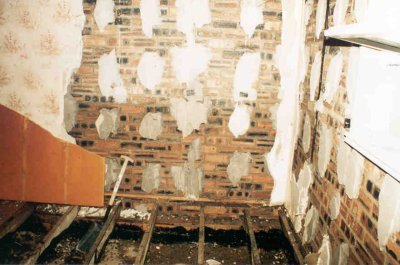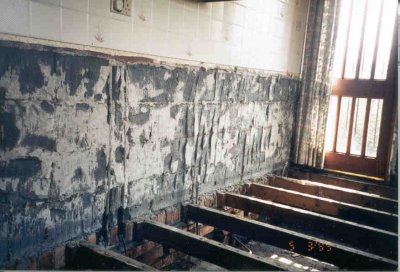

home > what to do > repairs > walls
 A
brick wall with the plaster finishing removed to allow inspection and drying
out (photo courtesy of WA Fairhurst & Partners, Dundee)
A
brick wall with the plaster finishing removed to allow inspection and drying
out (photo courtesy of WA Fairhurst & Partners, Dundee)
Any area of concern is best discussed with a surveyor or other building expert, who should be able to identify and assess points of weakness and rising damp in the wall, and give advice on how best to deal with them (consult your local Yellow Pages or the Yell.com Web site for contact details). If walls have sediment or debris piled high up against them (over 1-2') this will exert a force upon the wall (a loading); take care when removing loadings. Try to remove loadings in stages and seek to maintain levels inside and outside of walls if loaded on both sides.
Walls built of traditional brick or concrete block with mortar joints will in general dry out well. Some types of lightweight block may begin to lose strength following a period of standing in floodwater. Have these checked by a specialist.
Signs of buckling include horizontal cracking and areas that have moved out of vertical alignment. When this condition is minor, you need not repair the wall immediately. However, any noticeably buckled wall will eventually collapse from normal ground pressures and seasonal temperature changes. When buckling has seriously weakened the wall, the damaged parts should be rebuilt immediately. Vertical reinforcements may need to be constructed into walls over 15 feet long.
Settled walls and footings are indicated by vertical cracks either in small areas or throughout the structure. Repairs are difficult without special equipment. Contact a reliable contractor for this work.
Regularly check walls for cracks and rising damp, and consult a specialist if concerned. Record any de-lamination (splitting into layers) and joint expansion, in order that the damage to the building can be fully assessed.
Wash and disinfect all contaminated surfaces and remove all loose decorations (e.g. wallpaper or tiles). Remove any low-permeability internal finishes such as vinyl paper, ceramic tiles and gloss paint, which will slow down or prevent drying out. Hose and scrub down external walls.
It is important to drain away or remove standing water in cavities (both external and internal walls) as soon as possible. Inspect cavities either by getting a specialist to use an optical probe or by carefully removing bricks and identify the internal conditions. Remove any water, mud or debris from within and replace any corroded wall ties and insulation. In the case of wall ties it is advisable to bring in an expert to repair or replace them, and you will find that some builders will specialise in this field.
Dry brush off any efflorescence (growth of salt crystals) that forms on walls as they dry. The salt content of walls can be assessed, but generally it is best to bring in an expert in this case.
Anti-moisture sealants can cause significant problems. It is very difficult to give advice on how to deal with such substances, as they can be very variable in structure, how much they allow the wall to breathe and how long they last. Again, the best course of action is to bring in a professional, who may be found in the Damp-proofing & control section of the local Yellow Pages (or the Yell.com Web site), who can assess whether removal and replacement will be necessary.
Check that all airbricks in the walls are clear for ventilation.
Put in vents at about one metre intervals all round the building at damp proof course level at each floor level and at the top of cavities behind masonry cladding to speed drying. Again, you must consult a builder or professional before carrying out such an undertaking, (see BRE Good Repair Guide 11 for more information).
 A
blockwork wall with tiling and plaster removed to allow inspection and drying
out
A
blockwork wall with tiling and plaster removed to allow inspection and drying
out
20 November 2002